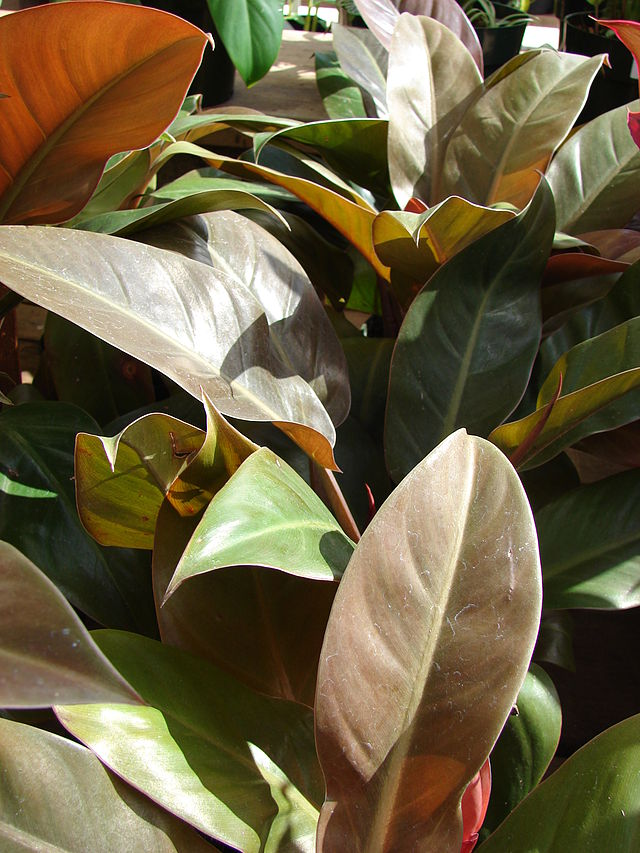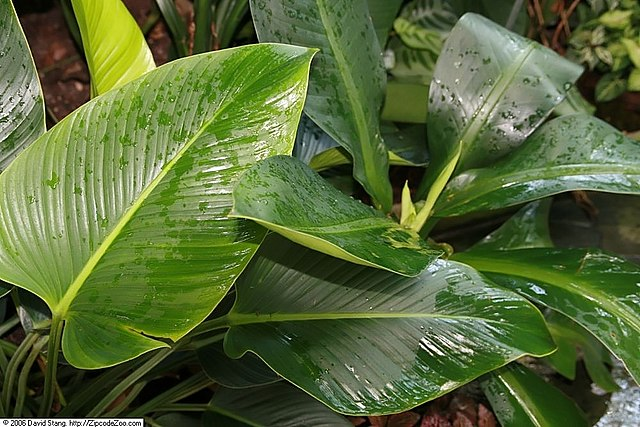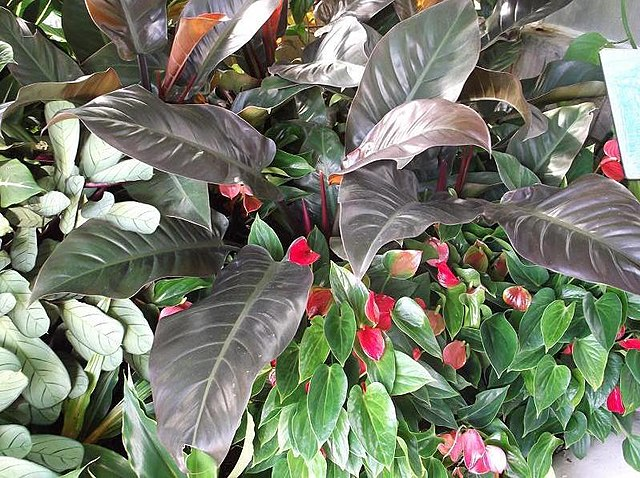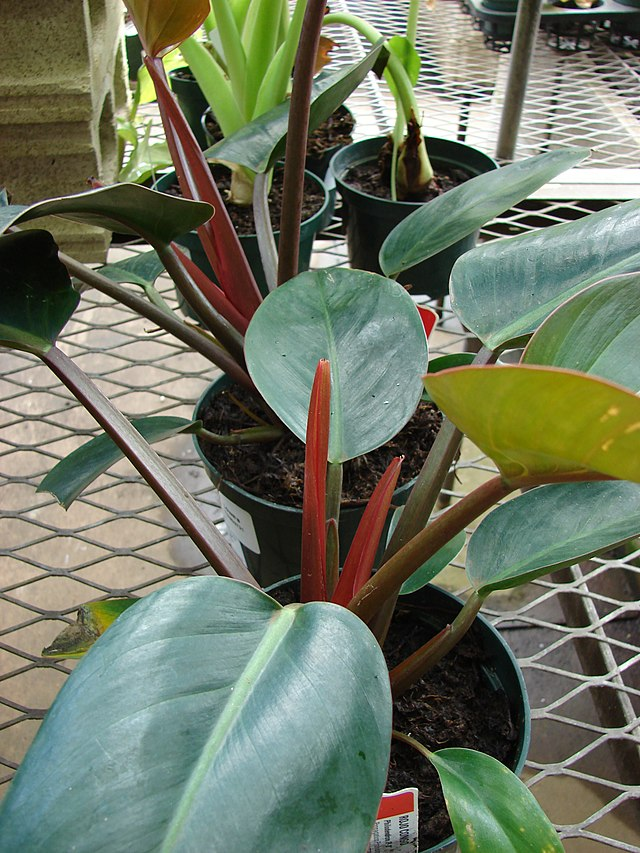Philodendron ‘Rojo congo’ is a huge, appealing evergreen perennial plant cultivar with rich scarlet stems and big, attractive oval to lance-shaped leaves. Philodendron “Rojo Congo” is a lovely warm-weather plant with spectacular flowers and fascinating foliage that was bred in Florida.
Philodendron “Rojo Congo” is an excellent indoor plant with an ideal growth habit for long-term cultivation. In addition, philodendron “Rojo Congo” care is so simple that even beginners may do it.
Learn more about this interesting plant here!

Philodendron Rojo Congo Profile
General Information
Philodendron Rojo Congo belongs to the Araceae family and the genus Philodendron. It is native to the rainforests. The Philodendron Congo Rojo is a lovely warm-weather plant with beautiful blooms and intriguing foliage. Philodendron Rojo Congo, also known as Red Congos, enjoys strong indirect light since it is part of the philodendron family, yet they may tolerate medium amounts of light as well.
This hybrid, a cross between Philodendron Imperial Red and Philodendron Tatei, prefers high humidity and strong indirect light.
Etymology
Philodendron “Rojo Congo” is a one-of-a-kind hybrid developed in Florida. The name “rojo” comes from the color of its young leaves, which are rich, lustrous crimson. As the leaves grow, they turn burgundy green.
The name “philodendron” comes from the Greek words “philo”, meaning “love” and “affection”, and “dendron,” meaning tree. So the Philodendron is loosely translated as “tree huggers” with these meanings. This is because they are often seen in the wild as tree climbers.
Flowering
Philodendron Rojo Congo blooms with magnificent flowers that are aromatic and come in white, pink, or purple. However, this plant rarely blooms. The red blossom of Philodendron Rojo Congo, is known as a spathe and spadix.
Season Of Interest And Purchasing
The Philodendron Congo Rojo is a vivid warm-weather plant with fascinating leaves and spectacular blossoms. One of the simplest plants to care for is the Rojo Congo Philodendron. They adapt readily to different lighting and water conditions and flourish well indoors. It will look stunning in almost any environment.
The Philodendron Rojo Congo is a rare houseplant. It thrives under ideal conditions and grows quickly. Their growing season lasts from early spring until late summer.
Growth
The plant may grow to be quite large, both horizontally and vertically. It has the potential to grow to be more than 42 inches wide and 30 inches tall. Their growing season goes from early spring to late summer. As a result, Rojo Congo will produce outstanding indoor plant decorations.
Philodendron ‘Rojo Congo’ Overview
| Scientific name | Philodendron ‘Rojo Congo’ |
| Common name/s | Rojo Congo, Pink Congo |
| Family | Araceae |
| Growth Habit | Herbaceous |
| Height and Spread | Depends on the space. Can grow up to 5 feet in height, and 3 feet in spread |
| Classification based on life cycle | Perennial |
| Origin and Distribution | Native to South America |
| Climate Zone | Generally warmer climate |
| USDA Plant Hardiness Zone | USDA Zone 9-11 |
| Color | Bright red that matures into glossy, burgundy shade |
Related: Philodendron Red Emerald: The #1 Care, Propagation and Watering Guide
Care Tips

Light Requirement
The Rojo Congo requires bright, indirect light to thrive. As a result, its broad, dark green leaves show a fantastic shade plant. In contrast, prolonged and intense sunshine causes the plant’s red pigment in the leaves to fade. It will, however, be completely fine under very low amounts of sun. Therefore, moderate natural light conditions are ideal when selecting a site for your Congo.
Temperature Requirement
Philodendron “Rojo Congo” requires tropical warmth to thrive. This cultivar has been hybridized for indoor growing and can withstand high temperatures. Rojo Congo prefers temperatures ranging from 65 to 80 degrees Fahrenheit. This does not indicate exposing your plants to extreme temperature variations, such as placing them in front of extreme sunlight.
These plants prefer warmth and are not cold-tolerant. As a result, you must keep them indoors and out of the reach of cold drafts.
Water Requirement
The Rojo Congo Philodendron requires weekly watering. However, remember that too much or too little water can both harm the plant. Here are some watering tips for these hybrid cultivars. Philodendron “Rojo Congo” demands slightly more moisture than naturally occurring philodendron species that have developed to resist drought.
The watering cycle for your plant is determined by the living conditions you provide. This will change when the temperature and amount of sunlight change with the seasons. This works out to around once every three days when kept indoors throughout the summer. Remember that to water consistently, the soil must be entirely loose and drain well.
Humidity Requirement
Humidity is usually not an issue in most homes. On the other hand, these plants can endure average household humidity. A humidity level of at least 50% is recommended for best outcomes. During the dry months, this plant is also tolerant of air drying. But a humidifier is always a good idea.
Providing a humid environment for your plants will help them grow larger and healthier.
Soil Requirement
Philodendron “Rojo Congo” is an epiphytic plant that feeds on organic waste and collects naturally around its roots. Therefore, loose, well-draining, organically rich soil is ideal. Perlite, coco chips, bark fragments, fine gravel, sand, and other coarse, chunky materials could be suitable by using a variety of organic components that keep the plant wet and supply nutrients.
Airflow is essential in potting soil because it helps the roots breathe.
RELATED: Philodendron verrucosum: The Number 1 Care, Propagation, and Watering Guide for This Velvety Plant
Fertiliser Requirement
These plants simply require organic soil additions that function as efficient slow-release fertilisers. That’s why, for tropical evergreens like philodendrons, I prefer organic plant feeding over chemical fertilisers. Fertilise your Rojo Congo Philodendron once a month during the spring and summer.
Fertilising your plants provides them with the necessary nutrients to promote and maintain strong, healthy growth. Fertilise in the fall and winter, when plants aren’t actively developing and taking nutrients from the soil.
Space Requirement
Rojo Congo will do well in just about any room. Place her in front of a bright window or even in a poorly lit room; an east or west window would be perfect. It adds elegance to any room, corridor, or patio and enhances the ambiance. However, since this Philodendron can grow up to 5 feet tall and 2 feet in spread, a large space is needed.
Growing And Planting Tips
Propagation
Philodendron Rojo Congo can be propagated in several ways.
Stem Cutting
The most common technique of propagation for climbing philodendrons is stem tip cutting, because philodendrons have visible nodes.
To propagate:
- Select a stem to propagate.
- Submerge in water.
- Place it in a bright area and wait.
- transfer to soil.
- Keep hydrated
Dividing The Offsets
Rojo congo grows from a single stem on which the leaves are arranged. Sometimes new shoots or offsets appear, therefore they can be easily separated and grow as individual plants.
To propagate:
- Select where the new stem is growing.
- Using a sterile knife, separate the new stem.
- Plant the new one in a prepared pot with substrate and continue to nurture it as an individual plant.
Air Layering
Air layering is a common gardening method to propagate.
To propagate:
- find whitish nodules on the stem below the node
- Cut the stem below that spot
- Coat the notched place with moss and then wrap together in a plastic bag
- Spray occasionally to maintain the moisture
- When the roots become visible through the plastic bag, carefully unpack it.
- Cut the stem just under the new root and plant it
Pruning
To keep them looking attractive, most houseplants benefit from some trimming. Pruning your Rojo Congo will improve the appearance of your indoor garden by removing any structural issues and stimulating new growth.
Rojo Congo sheds old leaves every month or two, so if you notice one that seems unhappy, simply cut it. Then, use sharp, clean shears to prune your Red Congo and remove any extra growth at the stem’s base.
Potting And Repotting
Repotting houseplants, including Philodendrons, is best done in the spring, summer, and early fall.
Philodendron “Rojo Congo” should be grown in a large pot. This plant develops quickly in the first couple of years. As a result, you’ll need to report your plant to a slightly larger container every year. Then, it’s time to report when the roots reach the sidewalls or grow out of the drain holes.
Touch the soil to see if it has gotten loose or if the roots have become overgrown to determine whether the plant is ready to be repotted. It’s best to avoid repotting indoor plants in winter if you can because they like to rest during the cooler months.
Philodendron Rojo Congo Care
| Light | Medium to indirect bright light |
| Temperature | Intermediate to warm, 65-80 degrees Fahrenheit |
| Water | Once a week, increased in summer, decreased in winter |
| Soil | Loose, well-draining, organic rich soil |
| Fertilization | Regular household fertilizer, once a month |
| Space | Large space |
| Propagation | Via stem propagation, air-layering, and offset division |
| Blooming | Rarely blooms, enough sunlight and maturity needed |
| Pruning | Regular pruning |
| Potting | Regular potting mix, use of perlite and orchid bark is recommended |
Problems And Troubleshooting
Overwatering
Plants that are constantly overwatered generally have yellow leaves. However, too much or too little water might also damage the plant. Philodendron “Rojo Congo” care requires more moisture than naturally occurring philodendron species adapted to drought endurance. Your plant’s watering cycle is dependent on the living conditions you give it.
To stop the yellowing, monitor your watering cycle. The plant will live if the roots have not rotted. Root rot is a plant disease caused by overwatering, inadequate drainage, or soil fungus. Preventing it is the best choice.
Underwatering
The Rojo Congo philodendron’s yellow or brown leaves are most likely a symptom of improper watering. If you ignore the plant for a week or longer, you’ll get crispy edges, and the soil becomes completely dry. One indicator of underwatering is droopy leaves.
Water thoroughly when the topsoil is dry. Don’t immediately drench the soil and give the plant a watering shock. Instead, start slowly until the plant gets used to a regular watering routine.
Nutrient Deficiency
Nutrient deficiency occurs when a Rojo Congo lacks an essential nutrient necessary for development. For example, the appearance of pale leaves on a normally darker plant might indicate a nutritional deficiency of magnesium.
If the plant’s distinctive burgundy-tinted leaves start to fade or grow slowly, it’s time to relocate Philodendron “Rojo Congo” to brighter lighting.
Flowering Problems
Sunlight is required for photosynthesis in plants. Lack of sunlight causes plants to grow slowly and fail to blossom. Your plant needs the right amount of direct sunlight, indirect light, or shade to thrive and blossom. Moving it to a different room or using an artificial grow light can assist.
Philodendron Rojo Congo Pests And Disease
| Common Pests/Diseases | Symptoms | Treatment and Prevention |
Common diseases include crown rot, stem rot, root rot, leaf spot, fungal diseases, and Xanthomonas infectiom | Yellowish rimming around black or dark brown spots on leaves | Avoid overwatering. Keep soil dry. Avoid too high humidity. Proper ventilation is needed around the plant. Remove infected parts of fungal infections to avoid spreading. |
| Common pests include mealybugs, spider mites, aphids, and scales | Visible insects on the surface | Spray plant with warm, soapy water. If infestation is present, use insecticide or neem oil. Use diatomaceous earth. |
Problems With People And Animals
Toxicity
Like those in other Araceae plants, the calcium oxalate crystals of the Philodendron Rojo Congo houseplant are toxic to humans, cats, and dogs. Chewing or biting into this plant causes oral irritation, a burning feeling, and swelling of the lips, mouth, throat, and tongue. In addition, pets may have stomach upset, vomiting, and diarrhoea.
Philodendron Plants Meaning And Symbolism
The plant generally represents good health and bounty. It also acts as a source of inspiration for artists.
Philodendrons symbolise a love of nature, perfect for plant lovers and those who have a strong passion for eco-friendly living. They also symbolise personal growth, so they would make an ideal gift for someone going through significant life events or making personal improvements.
| General Meaning | Good health, bounty, inspiration of artists |
| Symbolism | Personal growth, love of nature |
RELATED: Philodendron White Princess: The Complete Care, Propagation, and Watering Guide You Need
Landscaping And Gardening Ideas

Companion Plants
Rojo Congo is the ideal companion plant for adding a splash of colour in full sun or dappled shade. It creates a distinct contrast as an underplanting, and its philodendron family gives it better resilience to the majority of plants.
Most common houseplants, such as philodendrons, Schefflera, and peace lilies, withstand or even prefer moderate light, humidity, and water, making them ideal companions.
Other tropical plants go well with Philodendrons. Some of the plants you may consider include bird of paradise, areca palms, fire spike, heliconia, variegated arboricola, croton, chenille plant, and pentas. Some of these plants will have additional colours and hues of warm oranges and reds, perfectly complementing your excellent dark greens.
Landscaping Ideas
Medium-sized Philodendrons go well as accents inside a humid room or a cozy deck or patio. A full plant can also be placed in the corner of the house or along the entryway. Outdoors, it can be a filler plant for a garden corner, in between palm trunks, or under tall trees.
It can also be placed near pools to add even more tropical vibes as long as it won’t get splashed at.
| What to plant with | Bird of Paradise, Areca Palms, Fire Spike, Heliconia, Variegated Arboricola, Croton, Chenille Plant, Pentas, Peace Lilies, Scheffleras |
| What NOT to plant with | Basically nothing |
Conclusion

Philodendron Rojo Congo is just a very unique houseplant. Collectors are attracted to it because of its distinctive and stunning crimson leaves. Philodendron “Rojo Congo” is an excellent plant to add to your collection if you want to create a tropical hub in your home.
The Philodendron Congo Rojo is a lovely warm-weather plant with beautiful flowers and intriguing foliage. The burgundy green serves as an excellent backdrop against which all other plants stand out. It takes its name from its new leaves, which are a rich, glossy red.
Philodendron “Rojo Congo” is a hybrid between Philodendron “Imperial Red” and Philodendron Tatei. This enormous plant looks great in wide areas and contrasts pleasantly with green-leafed plants.
FAQS
Is A Philodendron Rojo Congo Rare?
Yes! The Rojo Congo Philodendron is known to be a rare Philodendron. This is because this plant is sought-after by plant collectors due to its striking burgundy foliage.
How Big Does Philodendron Rojo Congo Get?
Philodendron Rojo Congo can grow as tall as 5 feet. It also has a maximum spread of 2 feet. They can reach their maximum height and spread when given the right amount of care and attention.
Is Philodendron Rojo Congo And Red Congo The Same?
Yes! The Philodendron Rojo Congo and the Red Congo are the same plants. Rojo is a Spanish word that directly means Red.
Is Red Congo An Indoor Plant?
Yes, Red Congo Philodendron is a good indoor houseplant.
How Do You Propagate Rojo Congo?
Red Congo Philodendron can be propagated via three means. It can be done using stem propagation, offset division, and via air layering.
Editor’s Recommendations
Do you have other tips for taking care of Philodendron rojo congo? Share it with us in the comment section below. Also, check out our other articles:
Philodendron rugosum: The Care, Propagation, and Watering Guide You Need
Philodendron Spiritus Sancti: The Best and Complete Care, Watering, and Propagation Guide
Philodendron Splendid: The Fail-Proof Care, Propagation, and Watering Guide You Need







